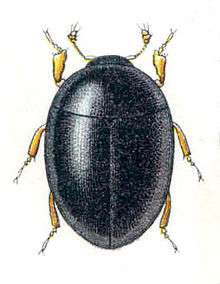Myxophaga
Myxophaga is the second-smallest suborder of the Coleoptera after Archostemata, consisting of roughly 65 species of small to minute beetles in four families. The members of this suborder are aquatic and semiaquatic, and feed on algae.
| Myxophaga | |
|---|---|
 | |
| Sphaerius acaroides | |
| Scientific classification | |
| Kingdom: | Animalia |
| Phylum: | Arthropoda |
| Class: | Insecta |
| Order: | Coleoptera |
| Suborder: | Myxophaga Crowson, 1955 |
| Families | |
Taxonomy
There are four extant families in the suborder Myxophaga divided between two superfamilies,[1] containing about 65 described species,[2] and at least two extinct superfamilies of the suborder.[lower-alpha 1]
- Superfamily Lepiceroidea
- Family Lepiceridae Hinton, 1936
- Superfamily Sphaeriusoidea
- Family Hydroscaphidae LeConte, 1874
- Family Sphaeriusidae Erichson, 1845
- Family Torridincolidae Steffan, 1964
- †Superfamily Rhombocoleoidea
- †Family Rhombocoleidae
- †Superfamily Schizophoroidea
- †Family Catiniidae
- †Family Schizocoleidae
- †Family Schizophoridae
Phylogeny
Little about the fossil record of Myxophaga is known, with only two fossils being described from Cretaceous amber. The first was originally placed in a new family, Haplochelidae,[3] but latterly moved to the family Lepiceridae.[4] The second fossil specimen from amber was placed in the Sphaeriusidae.[5] No impression fossils of myxophagan beetle were described until 2012, probably because of their small body size and specialized habitat.[6] This fossil specimen, from the Yixian Formation in the Jehol Biota, dates from the Early Cretaceous and shows that the development of Myxophaga must pre-date this period.[6]
Description
Myxophaga have several diagnostic features: the antennae are more or less distinctly clubbed with usually fewer than nine segments, mesocoxal cavities are open laterally and bordered by a mesepimeron and metanepisternum, the hind wings are rolled apically in the resting positions. Internally, they are characterised by the presence of six malpighian tubules and the testes are tube-like and coiled.[7]
Beetles of this suborder are adapted to feed on algae. Their mouthparts are characteristic in lacking galeae and having a mobile tooth on their left mandible.[8]
Distribution
Only two myxophagan genera are found in North America: Sphaerius and Hydroscapha.
Notes
- † Denotes that the group is extinct
References
- "Myxophaga". Tree of Life Web Project. 2007. Retrieved 2017-05-26.
- Mesaros, Gabor (2013). "Sphaeriusidae (Coleoptera, Myxophaga): A new beetle family to the fauna of Serbia". Bulletin of the Natural History Museum (6): 71–74. doi:10.5937/bnhmb1306071m.
- Kirejtshuk, A. G.; Poinar, G. (2006). "Haplochelidae, a new family of cretaceous beetles (Coleoptera: Myxophaga) from Burmese amber". Proceedings of the Entomological Society of Washington. 108: 155–164.
- Ge, S. Q.; Friedrich, F.; Beutel, R. G. (2010). "On the systematic position and taxonomic rank of the extinct myxophagan dagger Haplochelus (Coleoptera)". Insect Systematics and Evolution. 41: 329–338. doi:10.1163/187631210X537385.
- Kirejtshuk, A. G. (2009). "A new genus and species of Sphaeriusidae (Coleoptera, Myxophaga) from Lower Cretaceous Burmese amber" (PDF). Denisia. 26: 99–102.
- Cai, C.; Short, A. E. Z.; Huang, D. (2012). "The First Skiff Beetle (Coleoptera: Myxophaga: Hydroscaphidae) from Early Cretaceous Jehol Biota". Journal of Paleontology. 86 (1): 116–9. doi:10.1666/11-050.1.
- Beutel, R.; Leschen, R. (2005). "Morphology and Systematics (Archostemata, Adephaga, Myxophaga, Polyphaga partim)". Band 4 Part 38: Arthropoda, Hälfte: Insecta, Coleoptera, Beetles. Handbuch der Zoologie/Handbook of Zoology. 1. Walter de Gruyter. ISBN 3-11-017130-9.CS1 maint: ref=harv (link)
- Beutel & Leschen 2005, p. 43